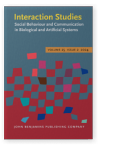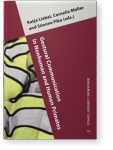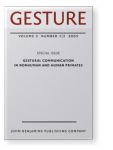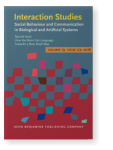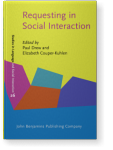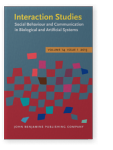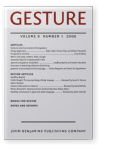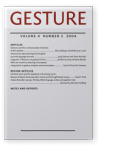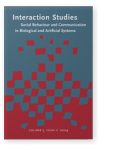Katja Liebal
List of John Benjamins publications for which Katja Liebal plays a role.
Journal
Titles
Developments in Primate Gesture Research
Edited by Simone Pika and Katja Liebal
[Gesture Studies, 6] 2012. xiii, 256 pp.
Subjects Cognition and language | Evolution of language | Gesture Studies
Gestural Communication in Nonhuman and Human Primates
Edited by Katja Liebal, Cornelia Müller and Simone Pika
[Benjamins Current Topics, 10] 2007. xiv, 284 pp.
Subjects Cognition and language | Cognitive psychology | Evolution of language | Gesture Studies | Signed languages
Gestural Communication in Nonhuman and Human Primates
Edited by Katja Liebal, Cornelia Müller and Simone Pika
Special issue of Gesture 5:1/2 (2005) 324 pp.
Subjects Cognitive psychology | Communication Studies | Signed languages
2020 The comparative neuroprimatology 2018 (CNP-2018) road map for research on How the Brain Got Language How the Brain Got Language – Towards a New Road Map, Arbib, Michael A. (ed.), pp. 370–387 | Chapter
We present a new road map for research on “How the Brain Got Language” that adopts an EvoDevoSocio perspective and highlights comparative neuroprimatology – the comparative study of brain, behavior and communication in extant monkeys and great apes – as providing a key grounding for hypotheses on… read more
2020 Mind the gap – moving beyond the dichotomy between intentional gestures and emotional facial and vocal signals of nonhuman primates How the Brain Got Language – Towards a New Road Map, Arbib, Michael A. (ed.), pp. 121–135 | Chapter
Despite the variety of theories suggesting how human language might have evolved, very few consider the potential role of emotions in such scenarios. The few existing theories jointly highlight that gaining control over the production of emotional communication was crucial for establishing and… read more
2018 The comparative neuroprimatology 2018 (CNP-2018) road map for research on How the Brain Got Language How the Brain Got Language: Towards a New Road Map, Arbib, Michael A. (ed.), pp. 370–387 | Article
We present a new road map for research on “How the Brain Got Language” that adopts an EvoDevoSocio perspective and highlights comparative neuroprimatology – the comparative study of brain, behavior and communication in extant monkeys and great apes – as providing a key grounding for hypotheses… read more
2018 Mind the gap – moving beyond the dichotomy between intentional gestures and emotional facial and vocal signals of nonhuman primates How the Brain Got Language: Towards a New Road Map, Arbib, Michael A. (ed.), pp. 121–135 | Article
Despite the variety of theories suggesting how human language might have evolved, very few consider the potential role of emotions in such scenarios. The few existing theories jointly highlight that gaining control over the production of emotional communication was crucial for establishing and… read more
2014 “Requests” and “offers” in orangutans and human infants Requesting in Social Interaction, Drew, Paul and Elizabeth Couper-Kuhlen (eds.), pp. 335–364 | Article
This paper presents two pilot studies of sharing situations in orangutans and human infants. We report on the communicative behaviors that elicit food transfers, the contingencies associated with gesture selection and the (relative) success in obtaining food. We focus on the sequential unfolding of… read more
2013 The hand-on gesture in gorillas (Gorilla gorilla) Interaction Studies 14:1, pp. 44–61 | Article
The gestural repertoire of captive gorillas contains the so-called “hand-on” (or “pat-off”) gesture in which one animals puts its flat hand on top of another’s head, which often leads to cessation of the receiver’s previous activity. We investigate the origins of this gesture and developmental… read more
2013 When apes point the finger: Three great ape species fail to use a conspecific’s imperative pointing gesture Interaction Studies 14:1, pp. 7–23 | Article
In contrast to apes’ seemingly sophisticated skill at producing pointing gestures referentially, the comprehension of other individual’s pointing gestures as a source of indexical information seems to be less pronounced.One reason for apes’ difficulty at comprehending pointing gestures might be… read more
2012 Handedness for manual gestures in great apes: A meta-analysis Developments in Primate Gesture Research, Pika, Simone and Katja Liebal (eds.), pp. 93–112 | Article
Left hemisphere dominance for language and speech is a prominent feature of the human brain. Some have suggested that left hemisphere lateralization for language in modern humans evolved from an existing lateralized system for gestural communication in the common ancestor of humans and apes. Here,… read more
2012 Where next? Developments in Primate Gesture Research, Pika, Simone and Katja Liebal (eds.), pp. 241–252 | Article
2012 Introduction: Developments in primate gesture research Developments in Primate Gesture Research, Pika, Simone and Katja Liebal (eds.), pp. 1–12 | Article
2012 Spontaneous use of gesture sequences in orangutans: A case for strategy? Developments in Primate Gesture Research, Pika, Simone and Katja Liebal (eds.), pp. 73–92 | Article
Great apes use gestures flexibly across different contexts and with a considerable degree of individual variability. However, little is still known about whether great apes combine gestures to increase the efficacy of their communicative attempts – either by anticipatorily attracting the attention… read more
2007 Introduction: Gestural communication in nonhuman and human primates Gestural Communication in Nonhuman and Human Primates, Liebal, Katja, Cornelia Müller and Simone Pika (eds.), pp. 1–4 | Article
2007 The gestural communication of apes Gestural Communication in Nonhuman and Human Primates, Liebal, Katja, Cornelia Müller and Simone Pika (eds.), pp. 37–51 | Article
Gestural communication of nonhuman primates may allow insight into the evolutionary scenario of human communication given the flexible use and learning of gestures as opposed to vocalizations. This paper provides an overview of the work on the gestural communication of apes with the focus on their… read more
2006 Gestural communication of orangutans (Pongo pygmaeus) Gesture 6:1, pp. 1–38 | Article
2005 Introduction: Gestural communication in nonhuman and human primates Gestural Communication in Nonhuman and Human Primates, Liebal, Katja, Cornelia Müller and Simone Pika (eds.), pp. 1–5 | Article
2005 Gestural communication of apes Gestural Communication in Nonhuman and Human Primates, Liebal, Katja, Cornelia Müller and Simone Pika (eds.), pp. 41–56 | Article
Gestural communication of nonhuman primates may allow insight into the evolutionary scenario of human communication given the flexible use and learning of gestures as opposed to vocalizations. This paper provides an overview of the work on the gestural communication of apes with the focus on their… read more
2004 To move or not to move: How apes adjust to the attentional state of others Interaction Studies 5:2, pp. 199–219 | Article
A previous observational study suggested that when faced with a partner with its back turned, chimpanzees tend to move around to the front of a non-attending partner and then gesture — rather than gesturing once to attract attention and then again to convey a specific intent. We investigated this… read more
